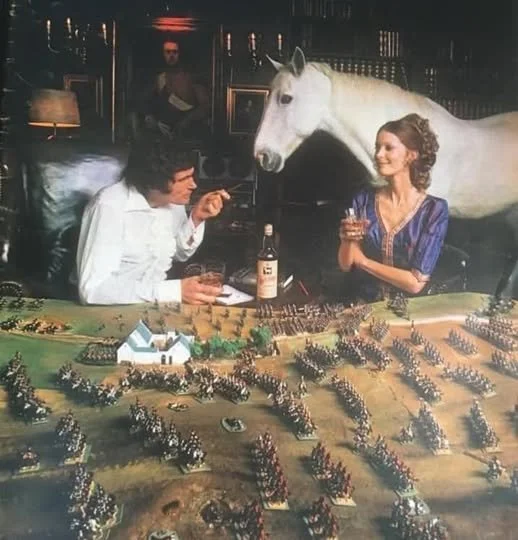TTS AAR: Marian Romans' First Outing
/With the varnish on the first two cohorts of blue-shield legionaries literally still drying, it was time to take the Marian Romans out for their first game of To The Strongest.
Looking at their list, the Romans have three basic options dependent on their commander: Caesar (Spain and Gaul); Pompeii (the East) and Sulla. My choice was to field a Caesarian army, mainly because I already have Gauls so wouldn’t need to paint any of them. My list was therefore as follows:
Proconsul
Two units of legionaries (one veteran)
Legate
Two units of legionaries (one veteran)
One unit of Cretan Archers
Legate
Two units of legionaries (one veteran)
One unit of legionary artillery
Allied Cavalry Leader
Two units of veteran Gallic cavalry
One unit of horse archers
I’m thinking that perhaps the Gallic cavalry should, if veteran, more properly be Germanic cavalry, as the Gauls fighting for Caesar didn’t seem to be very good whereas the Germans were very effective, but that’s something I can rectify in due course: for this battle they were hyped up on Getafix’s potion!
Kavan, my opponent, chose to field a Syracusan army. Not strictly speaking contemporary, but very much the sort of army the Romans had faced in the years leading up to the Marian period. His force consisted of:
Commander-in-Chief
One unit of Bodyguard Hoplites
One unit of Light Infantry
Commander
Two units of Gallic mercenaries
One unit of mercenary Greek cavalry
Commander
Two units of Syracusan Hoplites
Two units of light infantry
Commander
One unit of Syracusan Hoplites
One unit of Syracusan cavalry
One unit of light infantry
Initial Deployment
I deployed the Romans in a long line of Legionary bases, with the Gauls on the left wing.
The Roman Battle Line
A friend had warned me that being very much an infantry army, my flanks were very vulnerable, so although I felt my left was covered by the Gallic cavalry, I was very much aware that my right was somewhat ‘floating’, so just after the picture above was taken, I moved the legionary artillery onto the small hill behind the 9th/10th Cohorts.
Kavan also deployed in a long line but, obviously reading my mind, heavily weighted each flank i.e. his Gallic mercenaries were in the centre along with the bodyguard hoplites, but he had two hoplite units on his far right and one on his far left.
That’s an awful lot of syracusans
Battle is Joined
I opened proceedings by advancing slowly forward, holding my line. The Syracusan centre, on the other hand positively leapt forward. My Gallic cavalry annoyingly hung back, but this was countered by the fact thatb his right-flank hoplites were also slow to get going.
syracusan centre advances forward speedily
As the two centres approached each other, the action actually began on my right wing where, as predicted, the Syracusan cavalry attempted an outflanking manouevre, backed up by a unit of hoplites and some light infantry. The 9th/10th Cohorts turned to face them and the artillery opened fire.
The Syracusan cavalry were disposed of by the artillery (superb shooting!) and, for the rest of the game, the 9th/10th Cohorts would hold off the hoplites despite being attacked in their rear by more Syracusan light infantry. At one stage, the legionaries survived four consecutive rear attacks whilst disordering the hoplites in front of them. Plaudits and rewards all round!
cohorts IX and X hold the right flank against all comers
On the left wing, my Gallic cavalry were keeping the two enemy Hoplite units occupied, using their superior mobility to avoid a head-on clash and occasionally managing to threaten their flanks even if contact couldn’t be made. Two veteran cavalry units for two Hoplite units seemed a fair exchange to me, so it looked as if the action was going to be decided in the centre.
the two centres are about to clash
The legionaries and enemy Gallic mercenaries clashed first. I was expecting my pila to make a difference, but they didn’t really have much effect at all. The clash became a grinding melee where the quality of my legionaries was perfectly balanced by the size (and therefore extra hits) of the Gauls.
Slightly to the left of the above, my 1st/2nd and 3rd/4th Cohort unit were faced by two units of Syracusan light infantry. I just couldn’t get rid of these: every time I charged forward, they evaded, and I soon found my troops well in front of the rest of the centre. Kavan had done to me what I had done to his two Hoplite units on the far left!
cohorts I to IV distracted by light infantry
Eventually, however, one of his light units were caught and disposed of, leaving my legionary unit to turn either for the enemy camp or back towards the centre to drive into the back of the enemy who were, bu now, hard pressing my men there.
the centres have now clashed!
I decided that the Roman thing to do was to go to the aid of the legion, so two cohorts of fresh Roman infantry drove into the back of the Celtic mercenaries, smashing them from the table.
This proved too much for the Syracusans, who had by now lost enough troops to force a retreat. It had been a narrow victory for the Marian Romans.
Aftermath
Lots of lessons learnt about the capabilities of the Marians. I was very pleasantly surprised by the effectiveness of the Roman artillery, although I do feel that that was down to the cards they turned rather than any innate ability. On the other hand, I was disappointed with the Roman pila: the extra attack card was useful, but not decisive.
What was without doubt the key to victory, however, was the manouevrability of the Roman cohorts along with their staying power, particularly the three veteran units. I foresee interesting times ahead, particularly as the next fight will be with the Sassanids.












